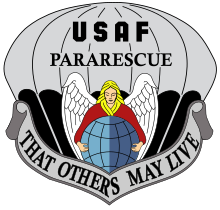Air Force Pararescue
| USAF Pararescue | |
|---|---|

U.S. Air Force Pararescueman flash (colorized)
|
|
| Active | March 1946 – present |
| Country |
|
| Branch |
|
| Type | Special operations force |
| Role |
Combat Search and Rescue Combat Medicine Direct Action |
| Part of |
|
| Nickname(s) | "PJs", "Maroon Berets", "Rescue Rangers", "Air Commandos" |
| Motto(s) | "These Things We Do, That Others May Live" |
| Color of Beret | Maroon |
| Insignia | |
| Maroon beret with Pararescueman beret flash | |
Pararescuemen (also known as PJs) are United States Air Force Special Operations Command (AFSOC) and Air Combat Command (ACC) operators tasked with recovery and medical treatment of personnel in humanitarian and combat environments. These special operations units are also used to support NASA missions and have been used to recover astronauts after water landings. They are attached to other SOF teams from all branches to conduct other operations as appropriate. Of the roughly 200 Air Force Cross recipients, only 24 are enlisted rank, of which 12 are Pararescuemen. Part of the little-known Air Force Special Operations community and long an enlisted preserve, the Pararescue service expanded to include Combat Rescue Officers early in the 21st century.
As early as 1922 there was a recognized need for trained personnel to go to remote sites to rescue airmen. In that year, Army Medical Corps doctor Colonel Albert E. Truby predicted that "airplane ambulances" would be used to take medical personnel to crashes and to return victims to medical facilities for treatment. However, it was another two decades before technology and necessity helped to create what would eventually become Air Force Pararescue.
Even so, there were developments in critical technologies. In 1940, two United States Forest Service Smokejumpers, Earl Cooley and Rufus Robinson, showed that parachutists could be placed very accurately onto the ground using the newly invented 'steerable parachute.' These parachutes and the techniques smokejumpers used with them were completely different from the techniques used by Army airborne units. It was in that year that Dr. (Captain) Leo P. Martin was trained by the U.S. Forest Service Smokejumper Parachute Training Center in Seeley Lake, Montana as the first 'para-doctor'.
...
Wikipedia

